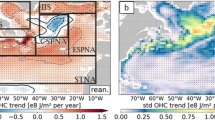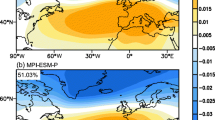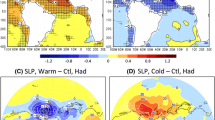Abstract
The interannual variability of the European winter air temperature is partially caused by anomalous atmospheric circulation and the associated advection of air masses, mainly linked to the North Atlantic Oscillation (NAO). However, a considerable part of the temperature variability is not linearly described by atmospheric circulation anomalies. Here, a long control simulation with a coupled atmosphere-ocean climate model is analyzed, with the goal of decomposing the European temperature (ET) anomalies in a part linked to the anomalous atmospheric circulation and a residual. The amount of interannual variability of each contribution is roughly 50%, although at subdecadal (overdecadal) time scales the variability of the residuals is dominant. These residuals are found to be linked to temperature anomalies of the same sign in the whole North Atlantic and Greenland, in contrast to the well-known temperature zonal seesaw associated with the NAO. The association between the residuals and other processes in the North Atlantic has been also analyzed. The thermohaline circulation, closely connected in the model to the intensity of the Gulf Stream, lags the evolution of the temperature residuals by several years and thus is not able to control their evolution. The variability of the oceanic convection in the Northern North Atlantic, on the other hand, correlates with the temperature residual at lags close to zero. It is hypothesized that oceanic convection produces a sea-surface temperature fingerprint that leads to the ET residuals. The implications of these results for multi-year predictability and for empirical climate reconstructions are discussed.















Similar content being viewed by others
References
Cayan D (1992) Latent and sensible heat-flux anomalies over the Northern Oceans—the connection to the monthly atmospheric circulation. J Clim 5:354–369
Cook ER, D’Arrigo RD, Mann ME (2002) A well verified, multiproxy reconstruction of the Winter North Atlantic Oscillation Index since A.D. 1400. J Clim 15:1574–1764
Delworth T, Greatbach R (2000) Multidecadal thermohaline circulation variability driven by atmospheric surface flux forcing. J Clim 13:1481–1495
Delworth T, Manabe S, Stouffer RJ (1993) Interdecadal Variations of the Thermohaline Circulation in a Coupled Ocean-Atmosphere Model. J Clim 6:1993–2011
Eden C, Willebrand J (2001) Mechanisms of interannual to decadal variability of the North Atlantic circulation. J Clim 14:2266–2280
Glueck MF, Stockton CW (2001) Reconstruction of the North Atlantic Oscillation, 1429–1983. Int J Climatol 21:1453–1465
Gulev SK, Barnier B, Knochel H, Molines JM, Cottet M (2003) Water mass transformation in the North Atlantic and its impact on the meridional circulation: insights from an ocean model forced by NCEP-NCAR reanalysis surface fluxes. J Clim 16:3085–3110
Häkkinen S (2000) Decadal air–sea interaction in the North Atlantic based on observations and modeling results. J Clim 13:1195–1219
Hastenrath S, Greischar L (2001) The North Atlantic oscillation in the NCEP-NCAR reanalysis. J Clim 14:2404–2413
Holland MM, Bitz CM, Eby M, Weaver AJ (2001) The role of ice–ocean interactions in the variability of the North Atlantic thermohaline circulation. J Clim 14:656–675
Holton, JR (1992) An introduction to dynamic meteorology, 3rd edn. Academic, San Diego, p 507
Johansson A, Barnston AG, Saha S, van den Dool HM (1998) On the level of forecast skill in the Northern Europe. J Atmos Sci 55:103–127
Kistler R, Kalnay E, Collins W, Saha S, White G, Woollen J, Chelliah M, Ebisuzaki W, Kanamitsu M, Kousky V, van den Dool H, Jenne R, Fiorino M (2001) The NCEP/NCAR 50-year reanalysis: monthly means CD ROM and documentation. Bull Am Meteor Soc 82:247–267
Labsea Group (1998) The Labrador Sea deep convection experiment. Bull Am Meteorol Soc 79:2033–2058
Latif M (1998) Dynamics of interdecadal variability in coupled atmosphere-ocean modes. J Clim 11:602–624
Latif M, Barnett TP (1994) Causes of decadal climate variability over the North Pacific and North America. Science 266:634–637
Latif M, Arpe K, Roeckner E (2000) Oceanic control of decadal North Atlantic sea level pressure variability in winter. Geophys Res Lett 27:727–730
Latif M, Roeckner E, Botzet M, Esch M, Haak H, Hagemann S, Jungclaus J, Legutke S, Marsland S, Mikolajewicz U, Mitchell J (2004) Reconstructing, monitoring, and predicting multidecadal-scale changes in the North Atlantic thermohaline circulation with sea surface temperature. J Clim 17:1605–1614
Legutke S, Voss R (1999) The Hamburg Atmosphere-Ocean Coupled Circulation Model ECHO-G. Technical Report No. 18, German Climate Computer Center (DKRZ)
Lohmann G, Gerdes R (1998) Sea ice effects on the sensitivity of the thermohaline circulation. J Clim 11:2789–2803
Luterbacher J, Xoplaki E, Dietrich D, Rickli R, Jacobeit J, Beck C, Gyalistras D, Schmutz C, Wanner H (2002) Reconstruction of Sea Level Pressure fields over the Eastern North Atlantic and Europe back to 1500. Clim Dynam 18:545–561
Mysak LA, Manak DK, Marsden RF (1990) Sea-ice anomalies observed in the Greenland and Labrador Seas during 1901-1984 and their relation to an interdecadal Arctic climate cycle. Clim Dynam 5:111–133
Paeth H, Latif M, Hense A (2003) Global SST influence on twentieth century NAO variability. Clim Dynam 21:63–75
Pickart RS, Spall AS, Ribergaard MH, Moore GWK, Milliff RF (2003) Deep convection in the Irminger Sea forced by the Greenland tip jet. Nature 424:152–156
Rahmstorf S, Ganopolski S (1999) Long-term global warming scenarios computed with an efficient coupled climate model. Climatic Change 43:353–367
Reynolds RW, Smith TM (1994) Improved global sea-surface temperature analyses using optimum interpolation. J Clim 6:929–948
Rodwell MJ, Rowell DP, Folland CK (1999) Oceanic forcing of the wintertime North Atlantic Oscillation and European climate. Nature 398:320–323
Roeckner E, Arpe K, Bengtsson L, Christoph M, Claussen M, Dümenil L, Esch M, Giorgetta M, Schlese U, Schulzweida U (1996) The atmospheric general circulation model ECHAM4: model description and simulation of present-day climate. Rep 218, Max-Planck-Institut für Meteorologie, Bundesstr 55, Hamburg, Germany
Seager R, Battisti DS, Yin J, Gordon N, Naik N, Clement AC, Cane MA (2003) Is the Gulf Stream responsible for Europe’s mild winters? Q J R Meteor Soc 128:2563–2586
Smith TM, Reynolds RW, Livezey RE, Stokes DC (1996) Reconstruction of historical sea surface temperatures using empirical orthogonal functions. J Clim 9:1403–1420
Stephenson DB, Pavan V, Bojariu R (2000) Is the North Atlantic Oscillation a random walk? Int J Climatol 20:1–18
von Storch H, Zwiers FW (1999) Statistical analysis in climate research. Cambridge University Press, Cambridge, p 484
Sutton RT, Allen MR (1997) Decadal predictability of North Atlantic sea surface temperature and climate. Nature 388:563–567
Timmermann A, Latif M, Voss R, Grötzner A (1996) North Atlantic interdecadal variability: a coupled air-sea mode. J Clim 11:522–534
Trigo R, Osborn TJ, Corte-Real JM (2002) The North Atlantic Oscillation influence on Europe: climate impacts and associated physical mechanism. Clim Res 20:9–17
Wanner H , Brönnimann S, Casty C, Gyalistras D, Luterbacher J, Schmutz C, Stephenson DB, Xoplaki E (2001) North Atlantic Oscillation—concepts and studies. In: Rycroft MJ (ed) Surveys in geophysics, vol 22. Kluwer, Dordrecht, pp 321–382
Weare BC, Nasstrom JN (1982) Examples of extended empirical orthogonal function analysis. Mon Wea Rev 110:481–485
Wolff JO, Maier-Reimer E, Legutke S (1997) The Hamburg Ocean Primitive Equation Model, Technical Report No 13, German Climate Computer Center (DKRZ), Hamburg
Wunsch C (1999) The interpretation of short climate records, with comments on the North Atlantic Oscillation and Southern Oscillations. Bull Am Meteorol Soc 80:245–255
Zorita E, Frankignoul C (1997) Modes of North Atlantic decadal variability in the ECHAM1/LSG coupled ocean-atmosphere general circulation model. J Clim 10:183–200
Zorita E, González-Rouco F (2002) Are temperature-sensitive proxies adequate for North Atlanctic Oscillation reconstructions? Geophys Res Lett 29(14):48-1, 48-4. DOI: 10.1029/2002GL015404
Acknowledgments
We thank C. Matulla and M. Montoya for their help at improving the manuscript. The help of the ’Arbeitsgruppe Klimaforschung’ of the Institute of Geography at the University of Würzburg is also much appreciated. Observational data provided by the NOAA-CIRES Climate Diagnostics Center, Boulder, Colorado, USA, from their Web site at http://www.cdc.noaa.gov/. The climate simulation was carried out at the German Climate Computing Center (DKRZ).
Author information
Authors and Affiliations
Corresponding author
Rights and permissions
About this article
Cite this article
Wagner, S., Legutke, S. & Zorita, E. European winter temperature variability in a long coupled model simulation: the contribution of ocean dynamics. Climate Dynamics 25, 37–50 (2005). https://doi.org/10.1007/s00382-004-0494-x
Received:
Accepted:
Published:
Issue Date:
DOI: https://doi.org/10.1007/s00382-004-0494-x




